
Macrocystis pyrifera
Giant Perennial Kelp
Macaulay Point, Juan de Fuca Strait, Esquimalt, British Columbia, Canada
29 November 2020
Observations started at 10:10am PST
Low Tide 8.5 feet at 08.38 PST (measured at Oak Bay Tidal Station)
Weather: Mostly cloudy, no precipitation, wind variable 0 – 10 km/hour, sea rippled with low westerly swell, temperature 8˚C, relative humidity 83%.
Phase of Moon: Waxing Gibbous (approx. 14 hours prior to the Full Moon); (Previous Phase, First Quarter, 21 November 2020 at 8.45pm PST: Next Phase, Full Moon, 30 November 2020 at 1:29am PST.)
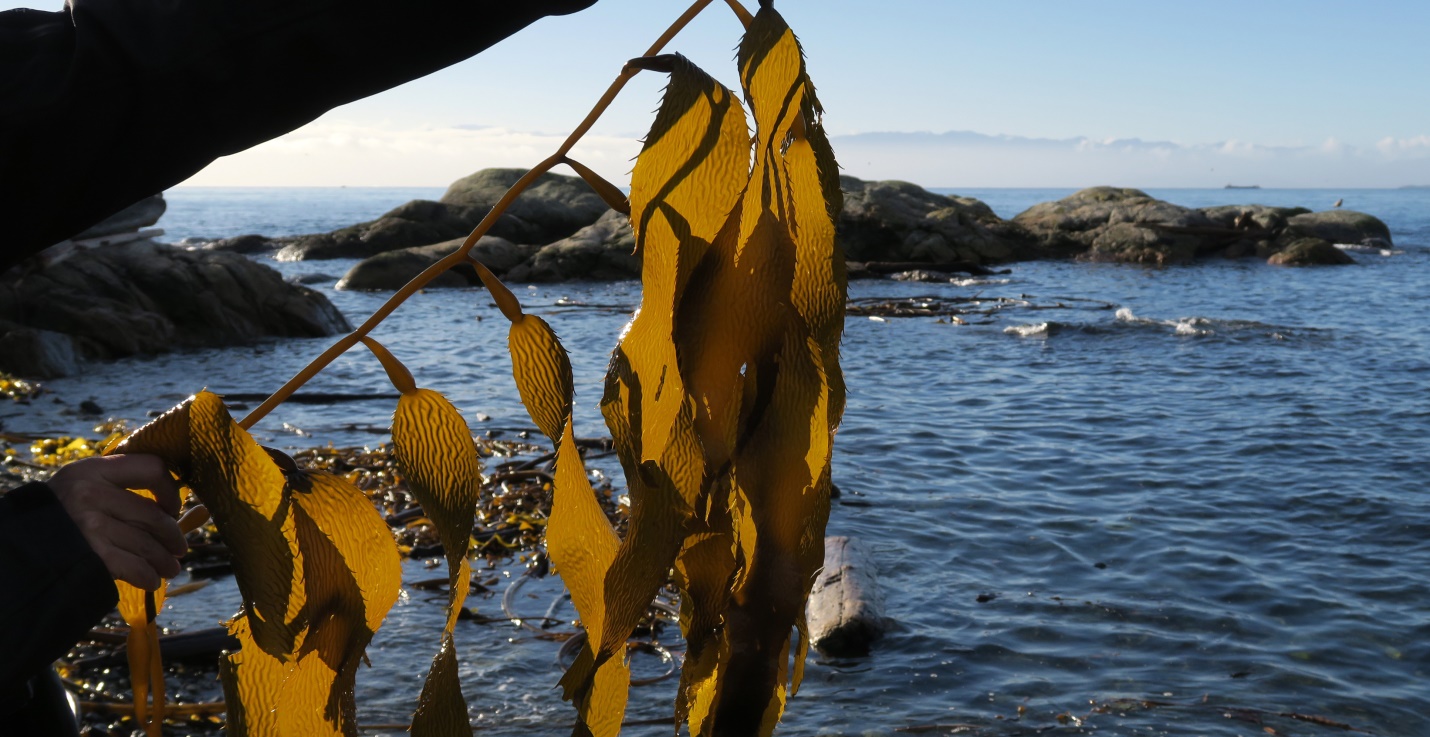
Figure 1: Macrocystis pyrifera, Giant Perennial Kelp – terminal section of one stipe held aloft to show distinctive growth habit; tangles of Giant Perennial and Bull Kelps can be seen floating in the bay behind; Macaulay Point, Juan de Fuca Strait, BC, Canada. November 28, 2020. Photo ID 27159 ©Seaweedwhisperings.com
In situ observations:
We interacted with/observed this seaweed in the high intertidal zone on a pebble beach between two bedrock points. Observations were done in situ with a recently washed ashore tangle of seaweeds. The Macrocystis pyrifera was intertwined with a few Bull Kelps (Nereocystis leutkeana) along with a few smaller alga species. This mass of seaweed measured approximately 8 meters long by 0.3 to 1 meter wide and 0.3 meters deep. The tangle contained entire Macrocystis plants, from holdfasts to the youngest tips; some holdfasts were still attached to rock that had been ripped from the seabed.
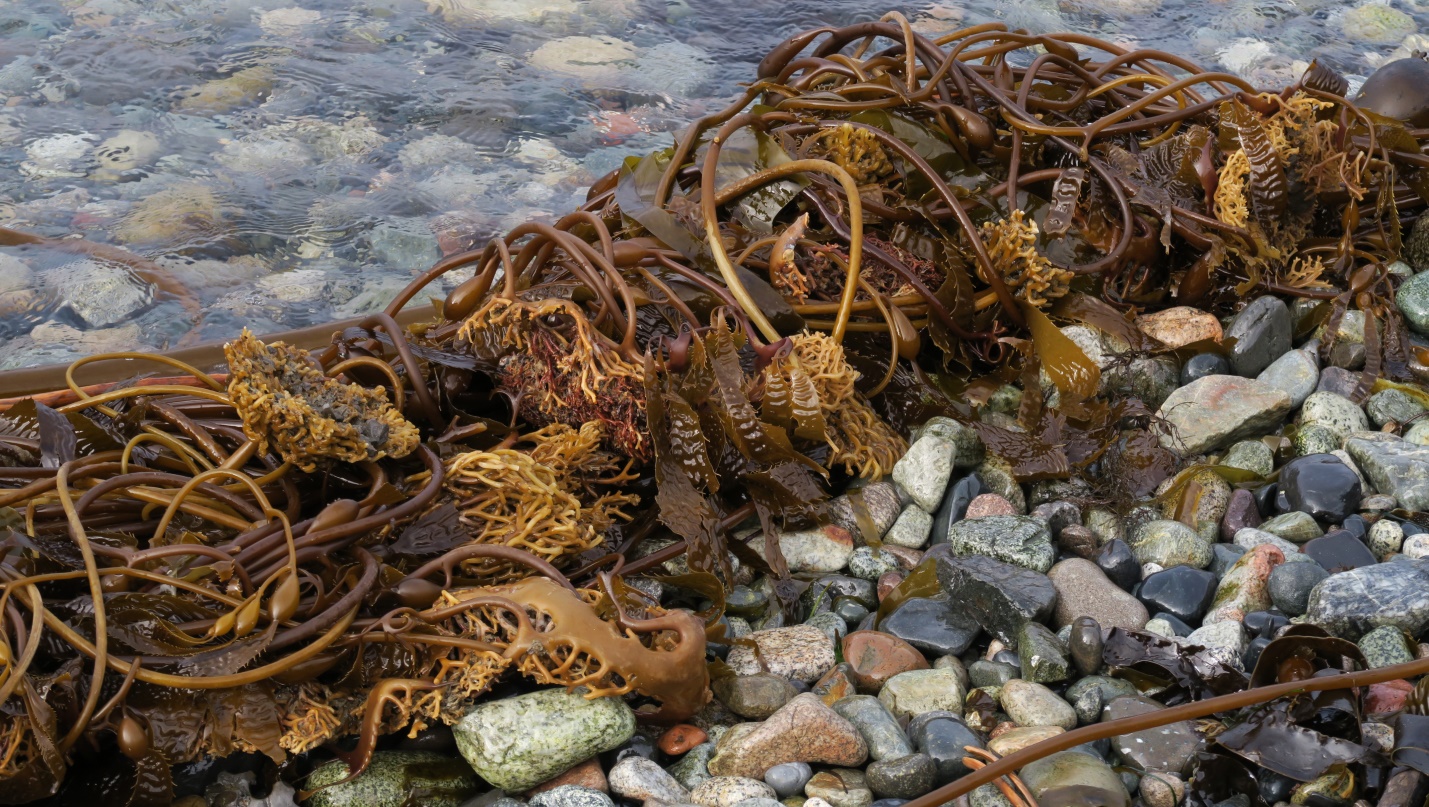
Figure 2: Macrocystis pyrifera – a tangled mass of algae at the shoreline. Visible here are the different forms of holdfasts, multiple individual stipes and numerous floats and blades of this seaweed; Macaulay Point, Juan de Fuca Strait, BC, Canada. November 29, 2020. Photo ID 27160 ©Seaweedwhisperings.com
Person 1:
My notes seem to be more orderly than usual (I was spending more attention to detail).
Stipes are uniform in diameter and cylindrical along their whole length.
Floats appear alike, are evenly spaced along the stipes; their positions are alternating and laterally opposite.
This mass of seaweed is coiled and tangled on the beach.
Are you intertwined with your society?
Leaf form is stunningly beautiful, with soft rippling ridges along the blades and evenly spaced spines along the margins.
From a distance the blades all look the same but close up each blade has a different ridge pattern.
Conforming on the surface, but individual beneath?
The holdfasts of this alga species are distinctive. Some form a simple cone from which a single stipe arises. On others there’s a solid, somewhat contorted shield or plate over the attachment structures. From this plate multiple stipes arise. Coloration is caramel brown/green (light olive).
Solid family values?
To me, the solid anchor plate represented the values, and the arising stipes represented the family members.
Sharp edges (to the blades) – don’t challenge my values!
I had several observations related to the feel of various parts of this seaweed.
Stipes – smooth but not slippery, there was a drag or resistance to my running fingers along them.
Blades – smooth and sensuous.
Holdfast and plate/shield – smooth and tough.
Feel when attempting to bite: can’t bite through the stipe or holdfast. Unpleasant thin cardboard texture upon biting the blade.
No taste.
After crunching a blade I was left with an extreme salty aftertaste – I needed a drink of water.
Iodine smell.
Community breakdown – set adrift, lost.
Person 2 was cutting part of this seaweed with a sharp blade. I observed the following.
The stipe appeared solid. When the stipe was cut we confirmed that it was solid. Fascinatingly a viscid material was present in the core. It could be slowly stretched into spider web-like strands which turned white (from translucent) when exposed to the air.
True communism – little hierarchy but nevertheless structured. This seaweed’s obvious structures are holdfasts, stipes, floats and blades.
Idealistic?
Everyone can live in harmony?
Then harmony can be destroyed when a dominant faction starts to realize that they can take advantage of this smoothly functioning cooperative community. At this point, hierarchy can take effect and equality and harmony disintegrate.
“Macrocystis” – large plant with cysts, which I guess refers to the floats.
“Pyrifera” – conical tapering floats.
“Giant Perennial Kelp” – good literal description of this seaweed.
Person 2:
A massive tangle of Macrocystis pyrifera rests here on the pebble beach between two bedrock outcrops. This is a huge mass of seaweed; it has a ‘presence’, firstly due to its size, and then once you are drawn nearer, due to its beauty.
Macrocystis is tangled with a few sticks and woody branches, and some stems of Bull Kelp.
We first saw you here yesterday – so glad we could return and find you still here today.
You have been torn from your rock anchors – and some holdfasts are still clasping a remnant chunk of this rock (sandstone?). In others your clasping fingers are empty – frozen in place where they grew to anchor you.
If we could unwind you, multiple, multiple stems of you, I wonder how many meters long you’d be? My guess – easily 10 meters or more.
Your main stem/stipe is about 1cm in diameter, and it is very strong.
In an average section, about every 25cm, the stipe bends ever so gently and a short fork leads to a float. The float is an elongated tear-drop shape, and from the end of that float the foliose aspect/blade of this seaweed grows – a thin, wide blade, that is approximately 8 – 10 cm wide and about 40cm long. Follow the stipe another 25cm, and this short fork, float and blade happens again; on and on, this is how this seaweed patterns its growth.
The blade is full of visual interest as it is rimmed with thin teeth – surprisingly sharp they are! And the blade has a wavy ridge pattern. It looks like the crests of these ridges could be the top of a thickened set of cords running within the blade, but in fact, there is no thickening. A cross section view reveals that the thickness of the blade is uniform and the ridges are a very fixed and rigid undulation of the surface. This is like corrugated metal roofing – but the pattern is far prettier, very attractive, to my eye.
Underwater this overall design must be beautiful to see. Each wavy pattered blade separated from the next and buoyed by its own personal float.
I think you do well, grow fast, take advantage of those calories your blades create and grow some more!
There are so many holdfasts in this tangle – like a whole community of plants. Again, much growth!
Stems floating and sometimes intertwined – when one part of the community loses its footing it takes the rest of the community with it.
I asked Person 1 to help me try to untangle a single stem/stipe of Macrocystis pyrifera so we could measure its length. We managed to loosen and separate a length that was over 15 meters long; then we could not pry any more of it from the tangled weave of seaweed it was part of.
Such great lengths of algae do not do well unanchored – they easily tangle into an impossible mess of holdfasts, stipes, floats, and blades.
I decided to cut various parts of this alga with a blade.
The stipe is a solid cylinder, has a paler colored 2mm center. Once cut, the exposed stem leaks a viscid, gummy substance from within. By touching this exposed area and pulling ones finger away – sticky strings are created, like spider webs.
I cut a float and discover it is hollow (appropriate to its function), but has very strong 2.5mm thick “skin”. It is hard to collapse even the cut bulb of the float by squeezing; intact, the floats are very, very hard to compress – sturdy! Strong! Will not fail at their job!
I ripped the blade and the same gummy threads are created.
You have a viscid gelatinous gummy sort of fluid in your parts, all of them!
Tasted a blade – very chewy, unpleasant to chew, but not offensive. Blade will chew up and feel sort of like a decent “meal”.
Tasted/bit into a float – super crunchy in an appealing way – very salty taste!
Your color is an olive green and it appears that you ‘age’ to a warm caramel brown color.
All parts are the same color, and stems and floats are smooth and translucent. The blades, however, catch the light in different ways and while they are also translucent they also have darker longitudinal wavy lines created by shadowing of texture.
Having observed more sections of a single stipe, I note that the spacing of floats, with their attached leafy blades, is much closer near the youngest tip of the stipe and much further apart closer to the holdfast. However, wherever you note this spacing, it looks even, well measured and proportioned, as if by careful design.
Community. You like being in a group of like-beings.
And I think you like being visited by others species, young fish, diving alcids and the like.
You like to “exchange” a bit but not so much that it would slow you from your task; you’ve got a plan, found your best design, and you’re forging onward with it! Yes, ever onward.
You’re rather strikingly beautiful but I think you are unaware of that.
Others notice your beauty; you just know the design works.
Beauty – yet you’ve got teeth!
I don’t think you bite, though. Those “teeth” are mainly for show, defensive, to make you appear tougher than you really are.
I think you enjoy moving, waving, undulating with the ocean swell.
You do a little wave, maybe a shy little shimmy, you’re interested, yes, shyly sexual. Not experienced and knowing, but definitely willing to tip your toes in that particular pond.
And how do you fare in that?
It all depends on the nature of the ‘partner’ you interact with.
If you are lucky, they are open, kind, willing to share and teach.
If you pick poorly, which can happen due to your naïveté, well, then I think you are shocked, will pull back in dismay, and in pain. Pain that you are ill-equipped to resolve.
The world is NOT “your oyster” now. You are bit tender and sensitive within.
You are dabbling and need to learn much, gather experience, find answers to build your confidence and world view.
You are good in like-minded community.
Opposition or aggression, you don’t like. It upsets your “world”, your sense of right and wrong, your balance.
You are confused by opposition and aggression, and also you’re offended – your peace is disrupted, your ideals, too, and once wounded that is not so easy to restore.
“Macrocystis” – “macro” – large, big view; “cystis” – cysts, so, large cysts.
“pyrifera” – “pyri” – fire, fiery; “fera” – iron, rusty. Terms like ‘forge ahead’ came to mind – a blacksmith forges iron in fire.
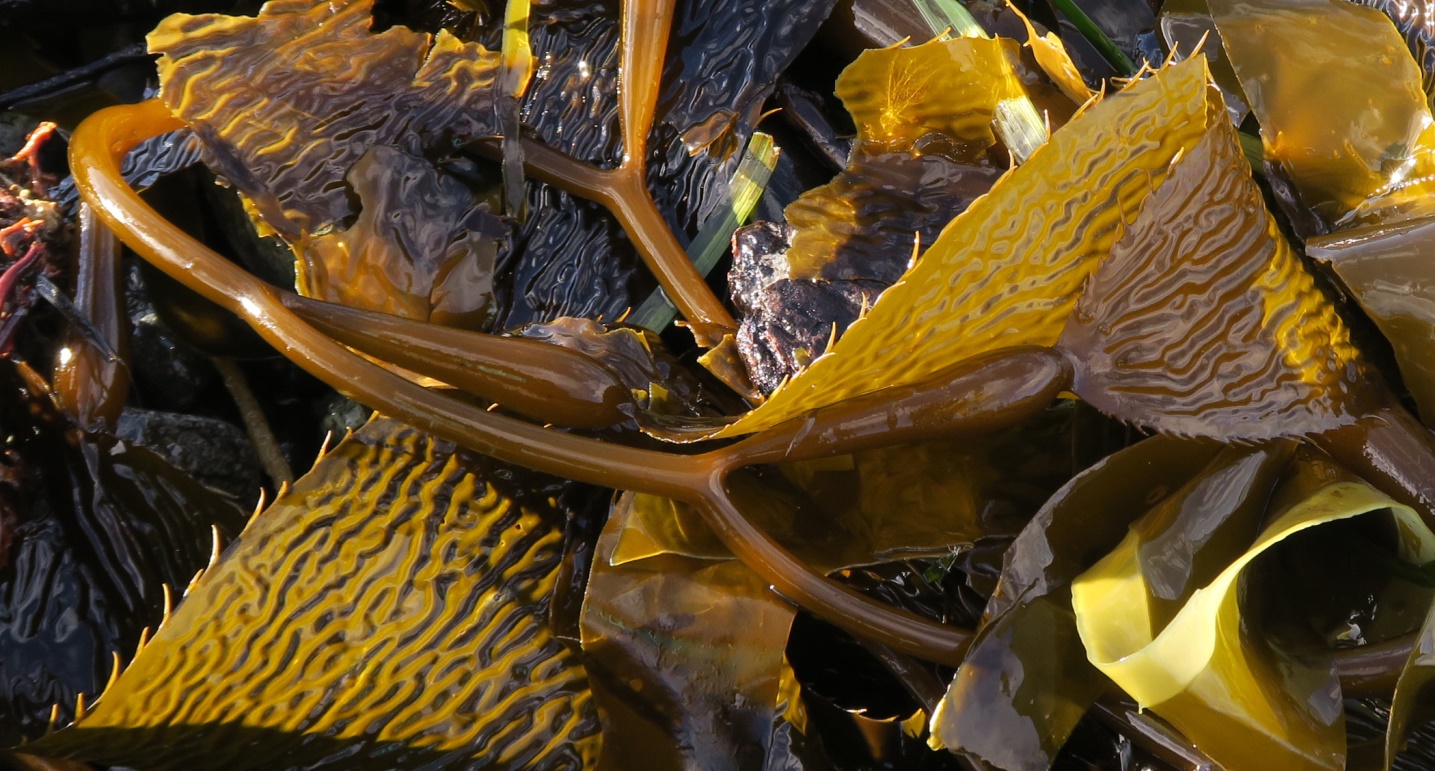
Figure 3: Macrocystis pyrifera, Giant Perennial Kelp – close view of stipe and the narrow floats at the base of each rippled, spine edged leaf blade; Macaulay Point, Juan de Fuca Strait, BC, Canada. November 28, 2020. Photo ID 27161 ©Seaweedwhisperings.com
Further Observations & Discussion:
We took so many measurements of this seaweed – all dimensions. This prompted us to consider the difference between the terms dimension and size.
Dimension is a measurable extent of some kind, such as length, breadth, depth or height. Size is the relative extent of something.
With this seaweed, its size is exceptional, it has a ‘presence’. The relative extent of this seaweed is not manifested in any one part, but rather in the collective.
Perennial aspect – this seaweed lives for years in the same location. How many years? What qualities does it have that allows the perennial life? Familiarity – with the environment, with whatever is there, nothing new needs to be learned next year to continue a successful existence. This has the positive of being able to build up a solid base of knowledge, you can enhance your home, enhance your family, and you don’t have to start fresh every minute or every day or every year because you’re confident in your established knowledge base.
The other side of this is limited ability to go outside known parameters – a definite downside. And you are probably not even considering the unknowns; you’re successfully living within what you already know. There is a hardened and wise aspect, but the wisdom is limited to the confines of one paradigm. It can give you all the information you want to know about life within that context, however, it has little ability to give wisdom or direction about how to extend beyond. The ‘wisdom’ is everything you need to know about how to conform to your societal values.
Person 1 had a past experience with Macrocystis while boating in the Southern Ocean. Attempting to pass through an extensive Macrocystis kelp bed (that was fully blocking the entrance to a bay) he quickly learned that propellers would get tangled and the bed was essentially impenetrable, except by paddling and therefore gliding over the surface. For this experienced boatman this interaction created a lasting memory. Jump forward, to this current interaction, and Person 1 felt with this seaweed the concept of strong community structure – so strong that it can be, in fact, an effective barrier.
What is this barrier about?
It can be a barrier to harmful outside forces that could bring disruption or change.
It can provide shelter – the shelter of familiarity. The barrier shields younger parts of the community as they grow. Also, in its environment, the Macrocystis kelp bed is a safe underwater forest that protects juvenile sea life.
It can be a barrier to individual personal growth.
The barrier also means ‘no safe life’ without your community.
This is where the related concept came in of true communism. Where everyone is equal and no one person’s role stands out as more important than another’s. There is a structure to life, and while roles/jobs may vary (i.e. holdfast, stipe, float, blade) the success of the community requires cooperation of each member.
There can be some individuality but the greater need is towards conformity because therein lies stability and safety. There’s very little impetuous to explore beyond what you already know, because tentative steps in that direction are quickly quashed by the protective yet limiting societal norms.
This cooperative structure is susceptible to hierarchical forces that will destroy the continuity of the community. This cooperative community can actually grow too big for its own good. At a certain size, it is very vulnerable to outside destructive forces. Its own mass (or success) aids in its destruction. This is the process inherent in the breakdown of all kinds of political regimes – totalitarian, kingdoms, democracies, any socio-political regime – the success of the society can lead to development of personally ambitious individuals, and there is much to exploit. These emergent leaders get too big, too fat, and can easily overwhelm and destroy the community structure.
Here, again we see the concepts of naïveté and distance/size. Start with a naïve simple format, take it along several generations, and you somehow get too far from the base values. Ultimately then weakening the community you started with.
Also, this links to the inherent strength of the stipes of this kelp. Like a technical climbing rope, they are uniform, sturdy, and very strong. So strong, that a dominant outside force such as a severe storm will not simply break off some parts of the stipes, but will uproot the whole “community”, holdfasts to leading tips. The whole community survives or no one survives.
Proportional size – measured, being careful what you say, doing things precisely, conforming to plan or design. Part of the beauty of this seaweed is this proportional design, you see it at all ages, the baby size, then the toddler, the child, teenager, young adult, mature adult… all the way up to the grand and great grandparent ages.
There’s something about the generations that is significant in this seaweed – the lineage, a clear linkage to ancestors.
The ancestral memory is held in the base, the holdfast, in the oldest part, and then every year it sprouts, and it does so in alignment with knowledge of the past. And, when ultimately this perennial dies, and therefore a plant must newly establish via sexual reproduction, this quality remains. This is more than transference of genetic material – the energy of this seaweed is one that reflects a strong ancestral awareness. The ancestral awareness is actually a working part of the present day efforts – without it, the community and/or individual feels lost.
It may seem contradictory to state that there is both naiveté in this seaweed along with ancestral knowing. This relates back to the first point discussed – size. The leading tips, therefore the youngest parts of this seaweed, are so distant from the ‘base’, the great-grandparent, that the knowledge may not be readily available. Within this naïve youngster there is a longing to belong, to know the familial history – in a figurative and literal sense, this is what anchors them, gives them their identity, and imparts confidence.
Very capable, yet also gullible, this type of personality can be enticed into joining a larger community such as a political group, a religious group, even a cult. They will not respond to being bullied or forced, but gentle, coaxing enticement is effective. Aggression, opposition and threatening circumstances are avoided; there is an inner tenderness and sensitivity. Ironically, the strong community structure masks and stifles expression of the gentle, sensitive aspects.
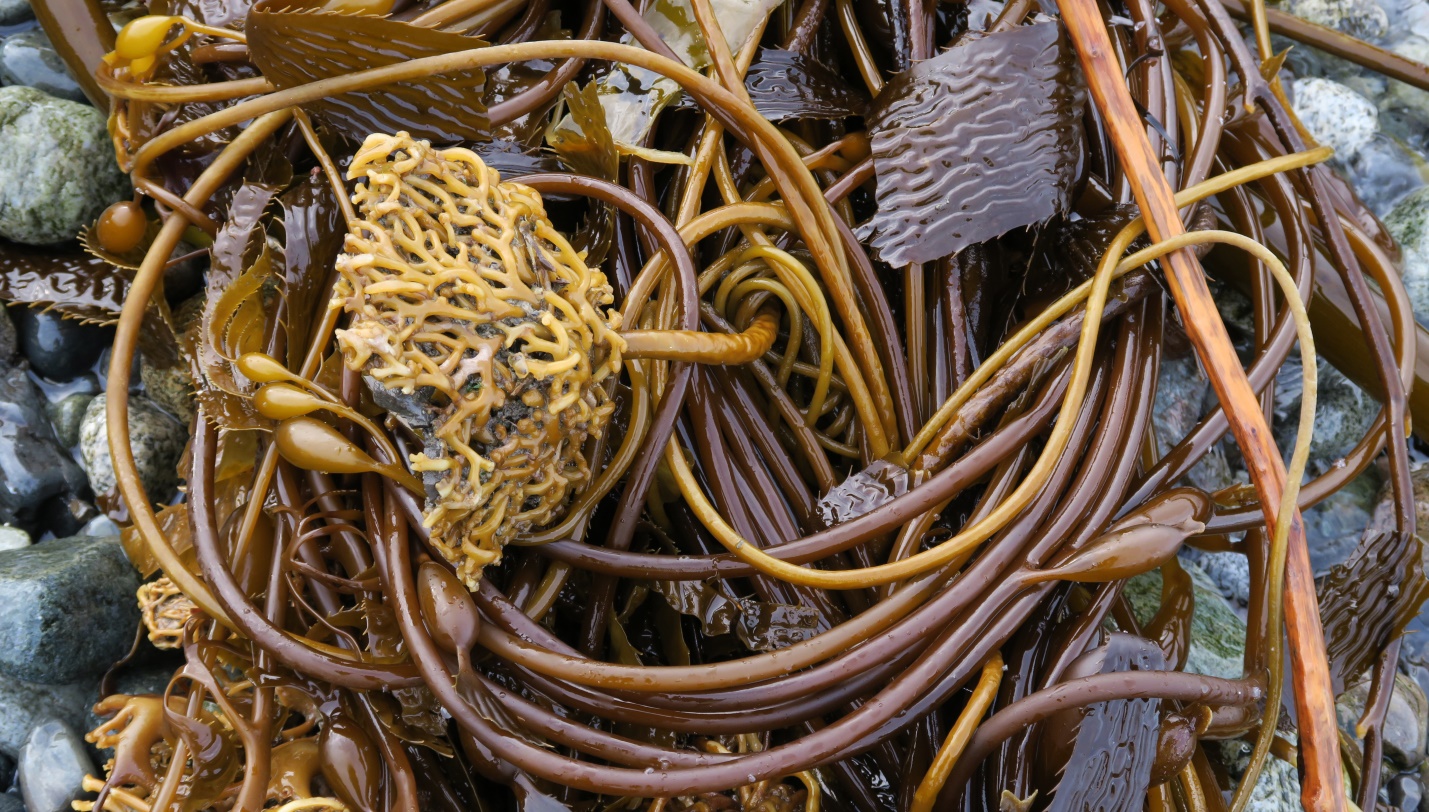
Figure 4: Macrocystis pyrifera, Giant Perennial Kelp – view of one conical holdfast and multiple stipes and bladders coiled in a paradoxically graceful-looking tangle as found at the tideline. This holdfast is grasping the chunk of substrate it had been anchored to before an early winter storm tore the whole ‘giant’ alga away. Macaulay Point, Juan de Fuca Strait, BC, Canada. November 29, 2020. Photo ID 27162 ©Seaweedwhisperings.com
Leaving the seashore:
There is a community boat launch near where we conducted our observations. An artist painted a mural on the base of a beacon stanchion there. This mural includes a circular panorama of sea life that occurs here including harbour seal, humpback whale, ochre pisaster sea stars, pacific octopus, chinook salmon, salmon fry, Bull Kelp and Giant Perennial Kelp. This mural seemed like a confirmation that this location was indeed a fitting place to interact with this notable seaweed, Macrocystis pyrifera.
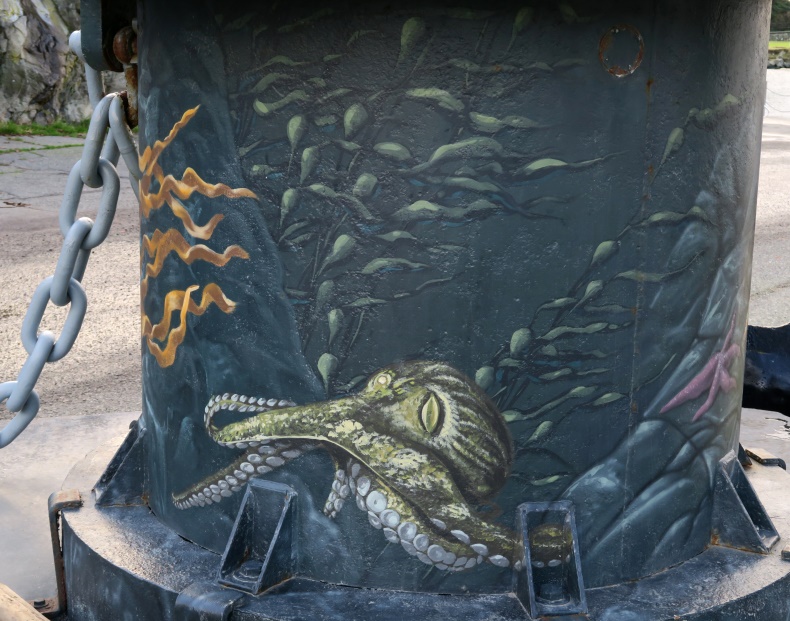
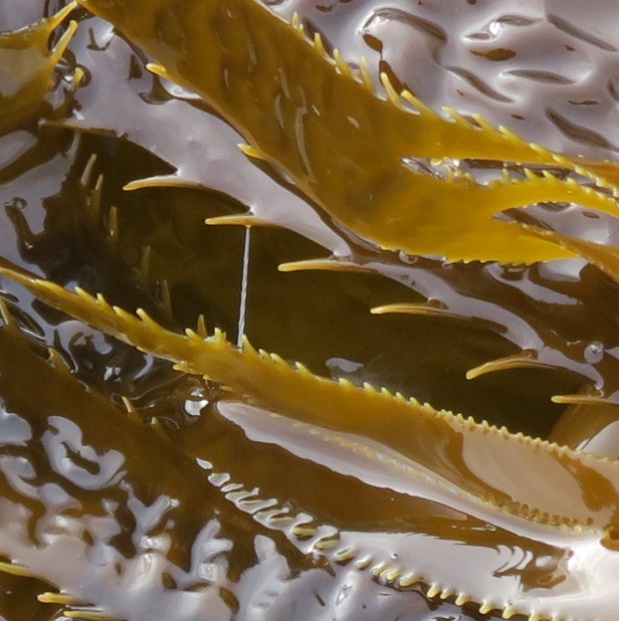
Figure 5 (Above left): Mural at Macaulay Point boat launch; depicting underwater sea life and Macrocystis pyrifera. November 29, 2020. Photo ID 27163 ©Seaweedwhisperings.com
Figure 6 (Above right): Close view of the ‘spines’ on the blade margins and one viscous ‘spider web-like’ string extending between two blades of Macrocystis pyrifera; Macaulay Point, Juan de Fuca Strait, BC, Canada. November 29, 2020. Photo ID 27164 ©Seaweedwhisperings.com
Biology & Natural History Information:
Habitat: Frequent, grows to create dense kelp forests, in rocky areas, low intertidal and subtidal zones. Macrocystis pyrifera is found, depending on water clarity, to depths ranging from 6 to 30 meters.
Pacific Coast Distribution: Alaska, the entire British Columbia coast, and coastal mainland USA to Baja California Mexico.
World Distribution: Also includes Peru; Chile; Argentina; Tasmania; New Zealand, sub Antarctic islands.
Description: A huge species of kelp with thalli that grow to 45-50 meters in length, this seaweed is a perennial that typically lives 4 – 8 years and is one of the largest algae. Numerous erect cylindrical stipes, often 2 to 6 times dichotomously branching near the base, arise from a holdfast. Blades occur at regular intervals along the stipe. Mature blades are wrinkled in an irregular pattern, have tooth-like projections along the edges and are fastened to the stipe by a basal pneumatocyst. Blades are numerous on each stipe, arranged at regular intervals.
Spores are borne on the stipe near the holdfast, with sporangia covering most of the surfaces. The motile sores of Giant Perennial Kelp swim actively towards sources of nitrogen (nitrate and low ammonium levels), glycine, aspartate, low iron levels, boron, cobalt and manganese – presumably all nutrients needed for growth. Studies on the Monterey Peninsula of California showed that the establishment of new sporophytes was inhibited in the presence of adult canopy cover. Researches concluded that sporophyte recruitment in Giant Perennial Kelp is therefore inhibited by low light levels. At exposed sites, where the adult canopy is often damaged or lost during storms, recruitment can be episodic and lead to large populations of juveniles.
A single Macrocystis species occurs in both the Northern and southern Hemispheres, being found along the Pacific coast of North America in the north and having cicumsubantarctic distribution in the south. Many species have been described based on morphological differences, later reduced to species based mainly on holdfast morphology. Macrocystis kelps experience a wide variety of environmental conditions because of their perennial nature, their growth habit reaching from deeper water to the surface, and the wide geographic distribution of the single species.
Giant Perennial Kelp forms extensive underwater forests in nearshore coastal ecosystems, where it plays an important role as a major primary producer as well as providing shelter for young fish, invertebrates and marine mammals such as sea otters and juvenile grey whales. The structure of Macrocystis kelp forests is dynamic and can change depending on factors such as storms, water temperature and herbivory.
Herring lay their eggs on this kelp, producing a specialty food that is harvested for export to Japan. The air bladders (pneumatocysts) are pickled and used in soups and pizzas, but use is not common as this species is found only at the lowest of low tides on exposed coasts. This alga is harvested in some regions to make kelp tablets used as a source of vitamins and minerals. It is a major source of alginate, a polysaccharide added to emulsions like salad dressing to make them smooth and creamy.
In southern California, Macrocystis pyrifera is extensively harvested, mainly for algin. This carbohydrate, found in brown seaweeds, i.e. kelps, is also produced by some bacteria. Algin is used medicinally to lower cholesterol levels and to reduce the intake in the human body of heavy metals such as strontium, barium, aluminum, cadmium, manganese, zinc, and mercury.
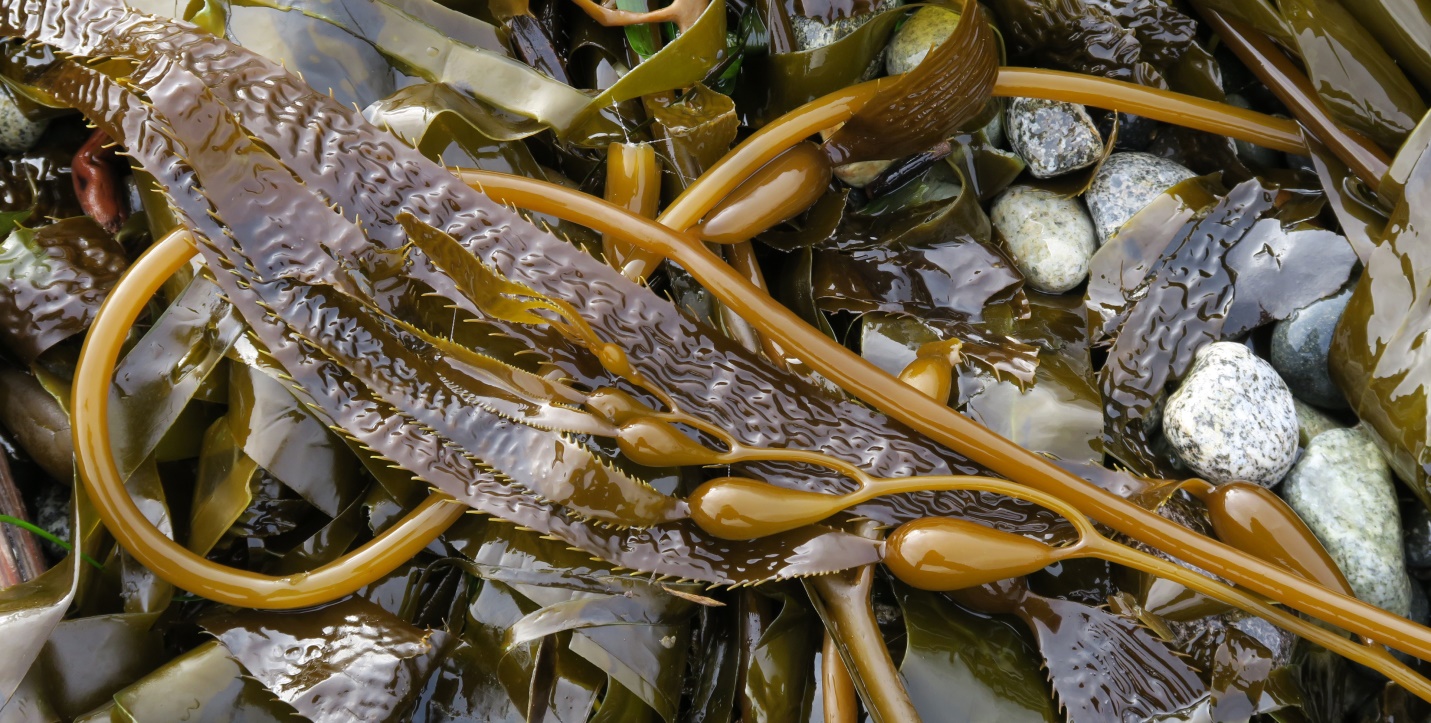
Figure 7: The very tip of a Macrocystis pyrifera thallus is pictured here (lying atop a larger blade). The pneumatocysts and their very small toothed bladelets are rather beautifully shaped and proportioned. At the very top of this thallus (with the tiniest pneumatocyst) there is a distinctive blade with numerous splits (in this photo 2 splits are visible) – this is how the newest blades originate. Macaulay Point, Juan de Fuca Strait, BC, Canada. November 29, 2020. Photo ID 27165 ©Seaweedwhisperings.com
An important species due to its ecological and economic values, much work/research has been conducted with Giant Perennial Kelp.
Some highlights are summarized here:
In Southern California, the lowered nitrate levels accompanying the 1982-84 El Niño depressed the growth rates of Giant Perennial Kelp. When scientists experimentally exposed individuals to nitrate/phosphate fertilizer, however, growth rates increased to normal values. In normal (non-El Niño) years, the growth of Giant Perennial Kelp is limited by light rather than by nutrients. Considerable genetic differences can produce physiological differences between individuals from different geographic areas. For example, individuals from Santa Catalina Island in Southern California achieved maximum growth rates at nitrogen concentrations typical of Santa Catalina habitats, which were lower than those found at Santa Barbara and Monterey Bay. Such geographic differences are likely widespread in algae.
Other studies in Southern California have shown that blades have the highest photosynthetic rates (especially blades that float near the surface and blade tips, where the tissue is more photosynthetic and less structural), with sporophylls showing only half those rates and stipes much less. No photosynthesis was detectable in holdfast tissue. Within blades, organic molecules can be transported at rates of up to 22 cm (8.7 in) per hour. The main carbohydrates are mannitol and alginic acid.
The marginal spines and textured surfaces of Giant Perennial Kelp blades increase turbulence as water flows over them and facilitate the uptake of carbon dioxide and other molecules from the water.
Giant Perennial Kelp dies back to its holdfast each winter. In southern California, three quarters of the tagged individuals were lost between October and March, probably because they were torn off the substratum by winter storms. Individuals can live up to 7 or 8 years, but most individuals survive only 4 or 5 years. The holdfasts of older individuals die in the center due to shading or to the accumulation of sediment. Red (Strongylocentrotus franciscanus) and, especially, Purple Sea Urchins (S. purpuratus) chew on the holdfast haptera, causing damage that also makes it easier for the alga to be torn off the rocks by storm waves.
Because it lacks tannins, Giant Perennial Kelp is more palatable than some other species of brown algae. The Bat Star (Asterina miniata) grazes young sporophytes and gametophytes in California, but once the blades are 1 to 3 cm (around 1 in) in height they are too large to be grazed by this sea star. The Northern Kelp Crab (Pugettia producta), and Red and Purple Sea Urchins all prefer to eat the Giant Perennial Kelp over species of Laminaria in California. The Concave Isopod (Pentidotea resecata) also eats Giant Perennial Kelp.
Many species of fishes depend on forests of Giant Perennial Kelp as nurseries for young stages and as habitat for adults. One study in Southern California showed that about one hundred species of fish are dependent on forests of Giant Perennial Kelp. Juvenile rockfish that hide in Giant Perennial Kelp forests prey on the larvae of nearby rocky shore invertebrates, giving this kelp an indirect role in structuring these nearby communities and tying intertidal community dynamics to offshore kelp forest health.
In Southern California, severe winter storms in 1980 removed all Giant Perennial Kelps but spared the understory species. With their preferred kelp gone, urchins then consumed understory species, disrupting the normal food chains. Then, in 1983, the urchins were eliminated by more severe winter storms and by the summer of 1984 the kelp forests had re-established (kelps 2 to 3 years old showed best survival in these storms). The effects of the storms therefore depended on the type of community present before the storms. When Giant Perennial Kelp is removed by storms, sometimes the opportunist Bull Kelp (Nereocystis luetkeana) becomes established instead.
In areas where wave exposure is extreme in California beds of Giant Perennial Kelp can be found further offshore in deeper water, where they are protected from the breaking surf. During times when wave intensity is low for extended periods, however, this kelp can quickly become established in shallower waters, only to be removed again during the next severe storm. Lack of disturbance therefore favors the establishment of Giant Perennial Kelp.
In central California, rafts of torn blades and stipes drift with the prevailing winds and are blown onshore in about a week or less. The pneumatocysts lose their buoyancy after about a week at sea, so longer range transport is unlikely. However, after being deposited on the beach, much of this kelp can be picked up on the next high tide and carried offshore where it sinks and thus impacts the food chain in benthic communities.
This species also occurs in New Zealand, and a study there showed that rafts of Giant Perennial Kelp are colonized by talitrid amphipods (beach hoppers) within one day of being washed ashore. The amphipod population peaked on the third day and then declined; meanwhile, nematodes (roundworms), enchytraeids (segmented worms related to earthworms), fly maggots and mites increased. After 18 days, only about half of the algal mass remained, but despite the fact that all of these animals undoubtedly fed on the decaying kelp, the researchers concluded that such processes as bacterial decay, leaching and fragmentation were the major causes of kelp breakdown.
Classification:
Phylum: Ochrophyta
Order: Laminariales
Family: Laminariaceae
Genus: Macrocystis
Species: Macrocystis pyrifera (Linnaeus) C.Agardh 1820
Synonyms and alternate names: Macrocystis integrifolia Bory
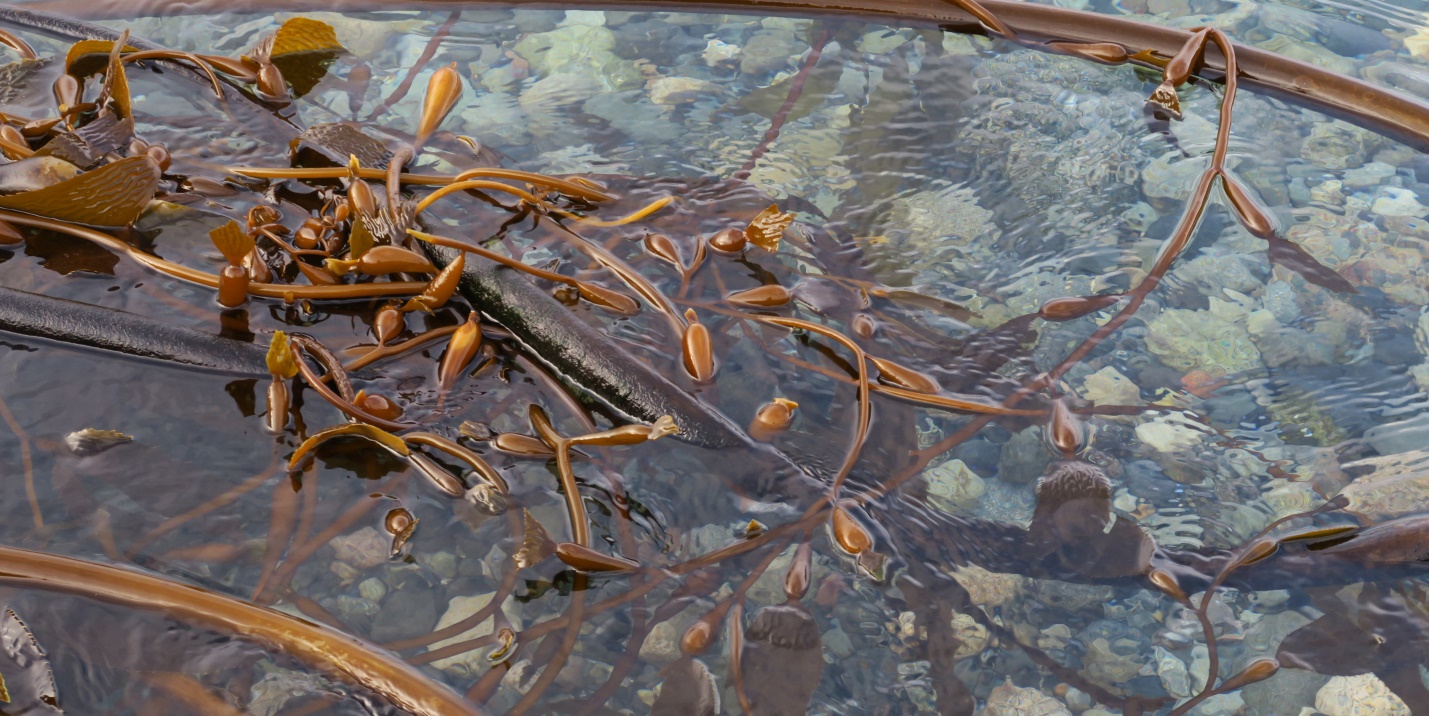
Figure 8: Macrocystis pyrifera stems & bladders afloat with a few Bull Kelp. The lightly rippled water surrounding is evocative of the wavy patterning on Giant Perennial Kelp blades and is, in fact, a turbulence created by the blades for optimal nutrient uptake from the water; Macaulay Point, Juan de Fuca Strait, BC, Canada. November 28, 2020. Photo ID 27166 ©Seaweedwhisperings.com
![]()